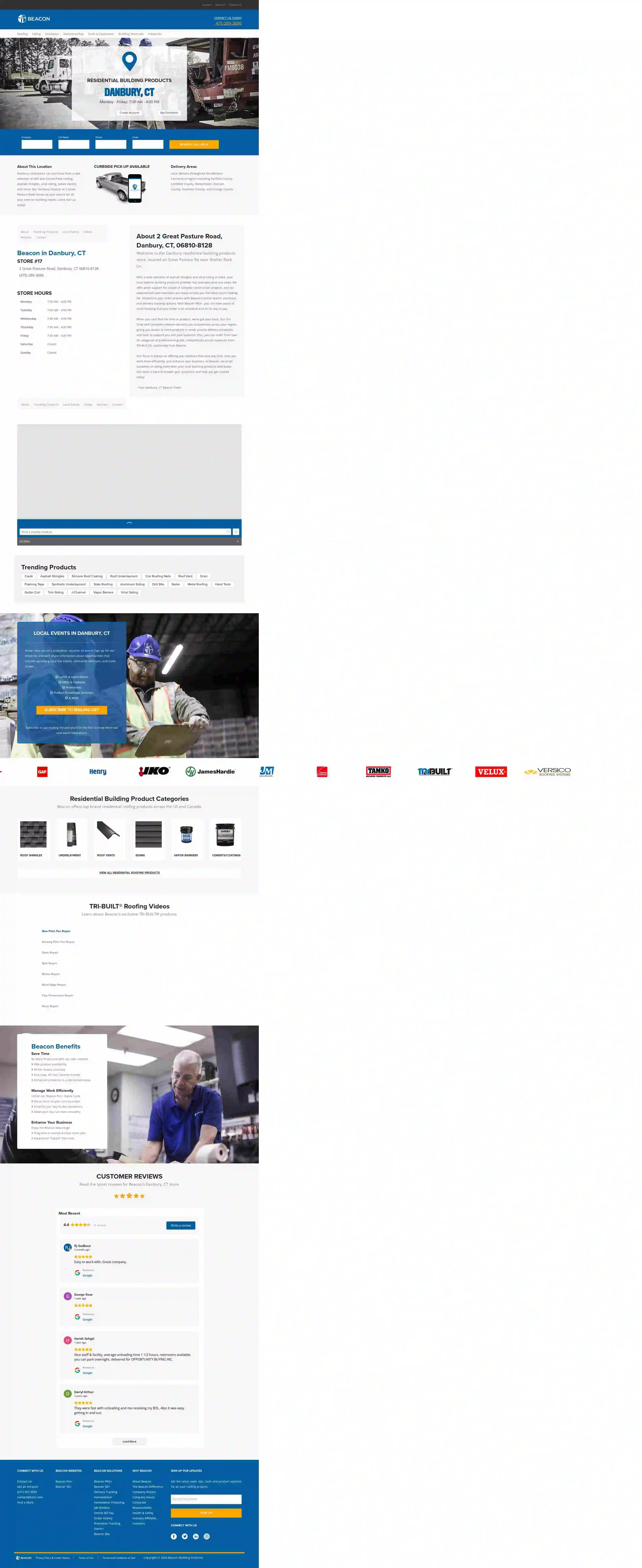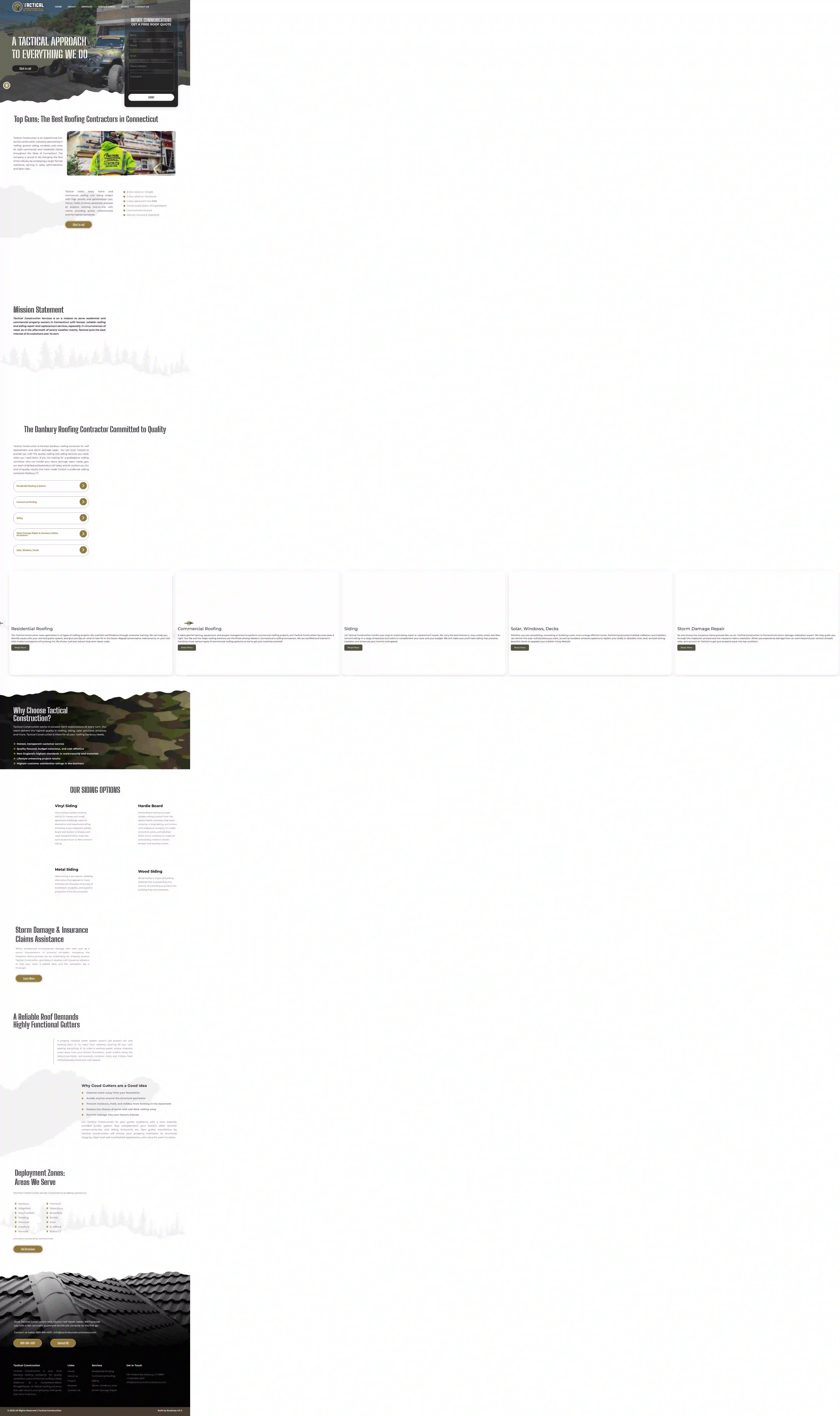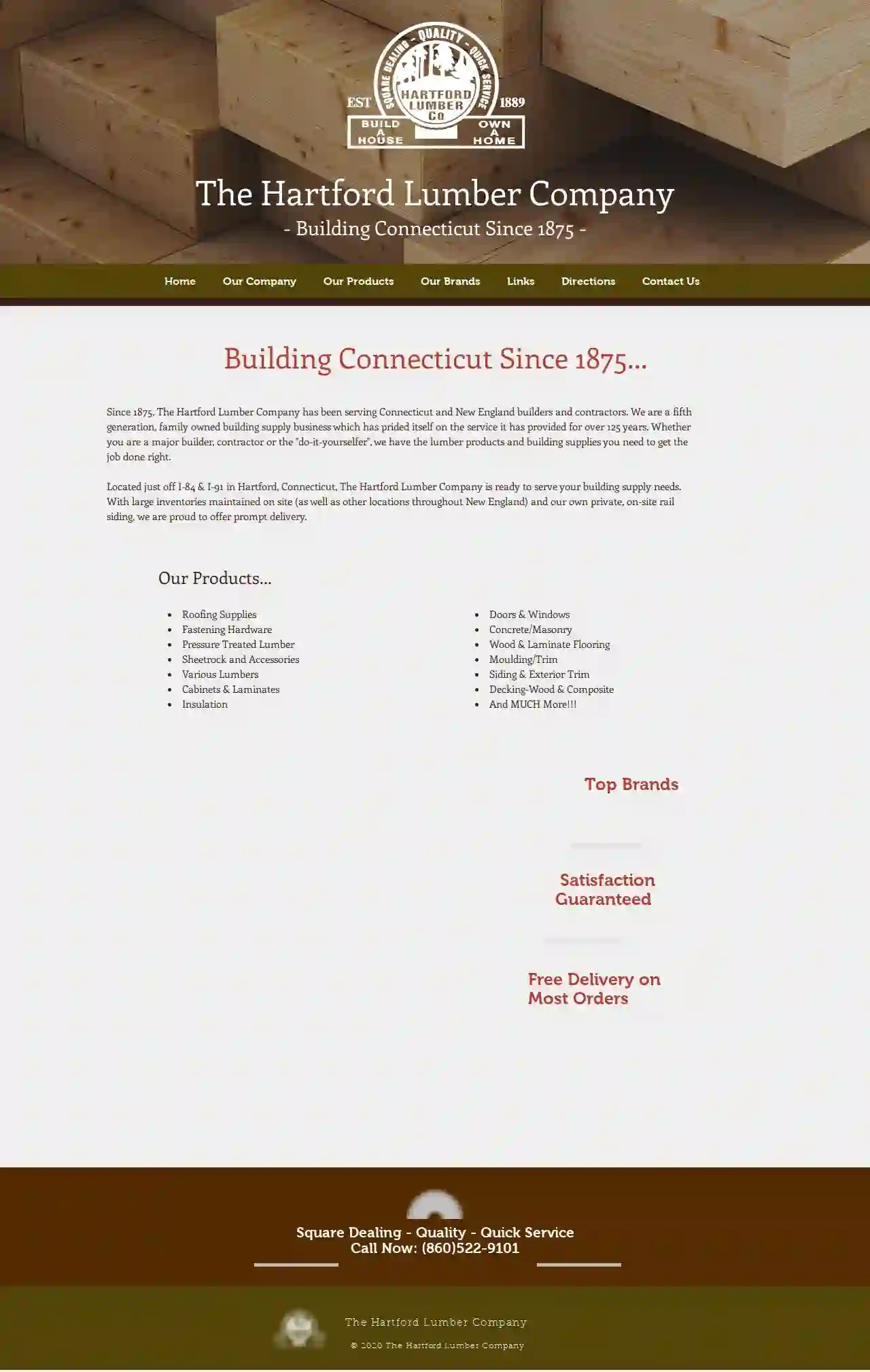Roofing Companies Newington
Find top Roofers in Newington
Get 3 FREE Roofing Service quotes for your project today! Compare profiles, reviews, accreditations, portfolio, etc... and choose the best service.

Elite Roofing
57 reviews615 West Johnson Avenue, Cheshire, 06410, USLocal Company Delivering Quality Roofing From commercial roofing to snow removal, maintenance and repair, the team at Elite Roofing does it all. Get a Quote Offering a wide selection of top-quality roofing services Fully Licensed & Insured HIC# 0610512 More than 30 years proudly serving the local community -Welcome to Elite- Quality Roofing, Even Better Services When you think of quality roofing options in and around Connecticut, where do you turn? For commercial roofing, there is no one better in the business than Elite. We have been installing quality commercial roofing products for years, and no matter if you are looking for a metal roof, or even EDPM, our team can deliver it with ease. Our maintenance and repair options are some of the best in the area, and no matter if you are dealing with a leak, a puncture, storm damage, or something a little worse, our team can patch and repair with the best of them. Finally, snow removal is a new service we are proud to supply our customers. Our trucks will ensure your driveway is clean as a whistle after a storm - that's the Elite promise! CERtified GAF Warranty CERtified ALLIED Warranty CERtified Mule-Hide Warranty ABC Supply Warranty Commercial Roofing When you are looking for commercial roofing options, the only team you need to look to is Elite. With EPDM, hot tar, metal covered and more, our team can deliver a top-end roof in no time. More Info Maintenance & Repair Dealing with a leak, an outdated roof, or something worse? Let the team at Elite Roofing take care of your maintenance and repair and enjoy a quality roof for years to come. More Info Snow Removal Nothing is worse than shoveling after a storm. Here at Elite Roofing, we're happy to take care of all snow removal and you can enjoy an extra cup of joe in the morning instead. More Info -About Us- A Local Company Delivering Quality Service Elite was founded to be a little different. We saw a need for a dedicated commercial roofing shop with the skills and expertise to handle maintenance and repair as well. Since our founding, we have worked on a variety of projects including grocery stores, malls and more than a hundred ma and pop shops in the greater Connecticut area. Today, we are proud to service our commercial clients with the roofing options they need, and with the addition of our snow removal service, the team at Elite is a true 365-day company. Now is the time to see what Elite can do for you and experience the difference a local company that truly cares can make on your commercial roofing project! More About Us -OUR CLIENTS- SUPERIOR RESULTS FOR ALL CLIENTS Here at Elite we're committed to doing our best work on each and every job - from the smallest residential snow shoveling to an expansive commercial roof installation. We're proud to say we've cultivated relationships with clients of all kinds throughout Connecticut. Our specialty includes commercial customers such as private building / companies, office space, car dealerships, grocery stores and more. And guess what? You may have seen our work before - we even did the WFSB News Room Building! -Service Area- A Local Company Delivering Quality Service Elite is proud to offer our commercial roofing and snow removal services to the Greater Connecticut area. This means our trucks can make maintenance and repair calls to New Jersey, New York, Rhode Island and Connecticut with ease and most importantly quickly. Call our team today and see how Elite can help you with your commercial roofing project or snow removal needs across the Greater Connecticut area and beyond.
- Services
- Why Us?
- Gallery
Get Quote
Beacon Building Products
4.313 reviews2 Great Pasture Road, DANBURY, 06810-8128, USWelcome to the Danbury residential building products store, located on Great Pasture Rd near Shelter Rock Ln. With a wide selection of asphalt shingles and vinyl siding in stock, your local exterior building products provider has precisely what you need. We offer great support for simple or complex construction projects, and our experienced team members are ready to help you find what you’re looking for. Streamline your order process with Beacon’s online search, purchase, and delivery tracking options. With Beacon PRO+, you can have peace of mind knowing that your order is on-schedule and on its way to you. When you can’t find the time or product, we’ve got your back. Our On-Time and Complete network
- Services
- Why Us?
- Gallery
Get Quote
Tactical Construction Services
4.619 reviewsDanbury, USTactical Construction Services is an experienced, full-service construction company specializing in roofing, gutters, siding, windows, and more for both commercial and residential clients throughout the State of Connecticut. The company is proud to be changing the face of the industry by employing a larger female workforce, serving in sales, administrative, and labor roles. Tactical treats every home and commercial roofing and siding project with high priority and personalized care. Owner, Pablo Jimenez personally oversees all projects, working one-on-one with clients, providing quality craftsmanship and the highest standards. The company is committed to serving residential and commercial property owners in Connecticut with honest, reliable roofing and siding repair and replacement services, especially in circumstances of need, as in the aftermath of severe weather events. Tactical puts the best interest of its customers over its own.
- Services
- Why Us?
- Accreditations
- Gallery
Get Quote
Hartford Lumber Company
4.230 reviews1000 Asylum Ave, Hartford, 06114, USThe Hartford Lumber Company has been serving Connecticut and New England builders and contractors since 1875. As a fifth generation, family owned building supply business, we have prided ourselves on the service we have provided for over 125 years. Whether you are a major builder, contractor or the "do-it-yourselfer", we have the lumber products and building supplies you need to get the job done right. Located just off I-84 & I-91 in Hartford, Connecticut, The Hartford Lumber Company is ready to serve your building supply needs. With large inventories maintained on site (as well as other locations throughout New England) and our own private, on-site rail siding, we are proud to offer prompt delivery.
- Services
- Why Us?
- Gallery
Get Quote
Flash Roofing & Restoration
510 reviewsConnecticut, USFlash Roofing LLC is a 5-Star service provider for Connecticut homeowners. We take care of your roofing project, whether at home or for your business. Our team is dedicated to providing exceptional service and ensuring your complete satisfaction. With years of experience and a commitment to quality, we are the leader in the pack. Just like man's best friend, Flash Roofing is your home's loyal protector.
- Services
- Why Us?
- Accreditations
- Our Team
- Testimonials
- Gallery
Get Quote
Master Roofers
4.882 reviews162 S Main St, Manchester, 03102, USMaster Roofers is a leading roofing company serving Central and Southern New Hampshire and North Shore Massachusetts. With over 80 years of experience, they pride themselves on providing high-quality roofing services and exceptional customer experiences. Their team of expert roofers is dedicated to using industry best practices and environmentally friendly policies to ensure lasting results. Master Roofers offers a wide range of services, including residential and commercial roofing, skylights, and gutter services. They are committed to transparency, explaining the entire roofing process to their clients and ensuring they understand how all components work together to protect their homes and businesses.
- Services
- Why Us?
- Accreditations
- Our Team
- Testimonials
- Gallery
Get Quote
Diamond Roofing Specialists, Inc.
3.812 reviews99 Brookside Road, Waterbury, 06708, USDiamond Roofing Specialists, Inc. provides both shingle and flat roofing service for homes and businesses since 1970. Each division has a dedicated team that are trained and experienced with a focus on safety. Our workplace is your roof, so the safety of your family or employees and our team members is our top priority.
- Services
- Why Us?
- Accreditations
- Gallery
Get Quote
Turner Home Improvement Contractors, LLC
4.992 reviews182 Oakwood Drive, Unit B1, Glastonbury, 06033, USTurner Home Improvement Contractors, LLC is a family-owned and operated business that has been providing commercial and residential roofing, siding, window, door, and deck services for nearly 70 years. Our office is centrally located in our hometown of Glastonbury, CT to better service Connecticut homeowners. We strive to continue the family tradition of quality craftsmanship at fair prices for many years to come. With a long history of supplying quality service and elite craftsmanship, we have received continued support from our clients and the community because of our experience, respect, eco-friendly options, registration, dedicated consulting, and multiple certifications. We prioritize customer satisfaction and never cut corners on any of our work. Our team is well-established, highly skilled, and ready to take on each and every project. We manage the planning, design, and construction of any project, meeting our clients' needs and expectations. We offer free estimates and are here for any and all your exterior home improvement needs.
- Services
- Why Us?
- Accreditations
- Testimonials
- Gallery
Get Quote
Connecticut Roofing Solutions- Roofing Specialist
569 reviews1034 Farmington Ave., West Hartford, 06107, USConnecticut Roofing Solutions is a trusted choice for roofing in West Hartford, Farmington, Avon, and more. We provide residential and commercial roofing installations, storm restoration, and insurance support. Our team of professionals is dedicated to providing a quality customer experience and ensuring your home or business stays covered. We take pride in our workmanship and use premium materials from top-tier companies like GAF, Firestone, and Mule-Hide. Contact us today for a free estimate!
- Services
- Why Us?
- Accreditations
- Gallery
Get Quote
Permasteelisa North America
4.441 reviewsMilan, Italy, Via G. Carducci, 20, 20121, USPermasteelisa Group is a global company that provides innovative design, engineering, and construction solutions for the built environment. With a history dating back to 1868, the company has grown to become a premium brand in the façade construction market. The company's three brands, Gartner, Permasteelisa, and Scheldebouw, offer bespoke and advanced technical solutions that meet clients' highest expectations. Permasteelisa Group has a global presence, with operations in America, Europe, Asia-Pacific, and the Middle East, and has delivered landmark projects around the world.
- Services
- Why Us?
- Accreditations
- Gallery
Get Quote
Over 17,196+ Roofing Contractors onboarded
Our roofing experts operate in Newington & beyond!
Roofyng.com has curated and vetted the Best Roofing Companies arround Newington. Find a trustworthy contractor today.
Frequently Asked Questions About Roofing Companies
- Metal roofs: Reflect sunlight, reducing cooling costs.
- Tile roofs: Offer thermal mass, regulating temperature.
- Cool roofs: White or light-colored roofs with high solar reflectance.
- Green roofs: Vegetated roofs providing insulation and reducing heat absorption.
- Safety First: Avoid going onto the roof during a storm, as it's dangerous.
- Document the Damage: Take photos and videos of the damage for insurance purposes.
- Contact Your Insurance Company: Report the damage to your insurance company as soon as possible to initiate a claim.
- Temporary Repairs: If safe, address any immediate leaks using buckets or tarps to minimize further damage.
- Contact a Roofing Contractor: After the storm, have a qualified roofing contractor inspect the roof and provide a repair estimate.
- Leaks or Water Stains: Water stains on ceilings or walls, dripping water, or dampness in the attic.
- Missing, Cracked, or Curled Shingles: Inspect for damaged or missing shingles, especially after a storm.
- Damaged Flashing: Look for rust, corrosion, or gaps in flashing around chimneys, vents, or skylights.
- Sagging or Uneven Rooflines: A sagging roof could indicate structural problems.
- Granule Loss: Excessive granules in gutters suggest aging asphalt shingles.
- Moss or Algae Growth: Can trap moisture and damage roofing materials.
- Hot Climates: Opt for light-colored or reflective roofing materials to reduce heat absorption. Consider tile roofs for their thermal mass and heat resistance.
- Cold Climates: Ensure your roof has adequate insulation and ventilation to prevent ice dams and moisture buildup. Metal roofs can shed snow effectively.
- High-Wind Areas: Choose roofing systems with high wind ratings and properly installed hurricane straps or clips to enhance wind resistance.
- Areas with Heavy Rainfall: Ensure your roof has proper drainage and a waterproof membrane to prevent leaks.
What are some energy-efficient roofing options?
What should I do if my roof is damaged in a storm?
What are some common signs of roof damage?
How do I choose the right type of roof for my climate?
What are some energy-efficient roofing options?
- Metal roofs: Reflect sunlight, reducing cooling costs.
- Tile roofs: Offer thermal mass, regulating temperature.
- Cool roofs: White or light-colored roofs with high solar reflectance.
- Green roofs: Vegetated roofs providing insulation and reducing heat absorption.
What should I do if my roof is damaged in a storm?
- Safety First: Avoid going onto the roof during a storm, as it's dangerous.
- Document the Damage: Take photos and videos of the damage for insurance purposes.
- Contact Your Insurance Company: Report the damage to your insurance company as soon as possible to initiate a claim.
- Temporary Repairs: If safe, address any immediate leaks using buckets or tarps to minimize further damage.
- Contact a Roofing Contractor: After the storm, have a qualified roofing contractor inspect the roof and provide a repair estimate.
What are some common signs of roof damage?
- Leaks or Water Stains: Water stains on ceilings or walls, dripping water, or dampness in the attic.
- Missing, Cracked, or Curled Shingles: Inspect for damaged or missing shingles, especially after a storm.
- Damaged Flashing: Look for rust, corrosion, or gaps in flashing around chimneys, vents, or skylights.
- Sagging or Uneven Rooflines: A sagging roof could indicate structural problems.
- Granule Loss: Excessive granules in gutters suggest aging asphalt shingles.
- Moss or Algae Growth: Can trap moisture and damage roofing materials.
How do I choose the right type of roof for my climate?
- Hot Climates: Opt for light-colored or reflective roofing materials to reduce heat absorption. Consider tile roofs for their thermal mass and heat resistance.
- Cold Climates: Ensure your roof has adequate insulation and ventilation to prevent ice dams and moisture buildup. Metal roofs can shed snow effectively.
- High-Wind Areas: Choose roofing systems with high wind ratings and properly installed hurricane straps or clips to enhance wind resistance.
- Areas with Heavy Rainfall: Ensure your roof has proper drainage and a waterproof membrane to prevent leaks.